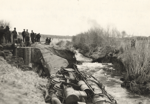By Earl Cater
From the "Empire Press."
August 14, 2025

The 1910 WSU agriculture train at the new Waterville Depot.
We have not shared much recently about the Great Northern Goat and its trek through Douglas County. This past week, we received a couple of pictures that raised questions and brought the railroad back into focus. In the fall of 1910, excitement boiled over from a sweet blend of something new crossed with necessity. The railroad rolled through communities, belching black coal smoke, grinding out its clickety-clack iron-on-iron noise, the huffing and puffing of a heavy steam engine, and a whistle echoing across the countryside.
Capable of swiftly moving people, livestock and wheat out of Douglas County, the railroad changed the county’s economics with a dynamic connection to markets worldwide. The arrival of the opening day of the Waterville Railway Company drew a huge crowd. An excursion car was brought in, and passengers were treated to a ride. Just two weeks later, the Washington State University Agriculture Department brought in a trainload of experts with new equipment, methods and seminars. Man, this train stuff was downright fun!
However, the new pictures indicated the railroad also created a healthy share of problems. The first heartbreak came just two years later. Four commercial clubs from around Douglas County met in Waterville to file a formal protest with the Great Northern Railway. Arrangements made to bring people to the Douglas County Fair turned into a bust. The 100 people who left Wenatchee on the train Thursday morning did not arrive at the Potato Carnival until after 1 p.m. After a brief visit, they needed to board the train four hours later at 5:30 p.m., and did not arrive home until 1 a.m.
It was about this time that another new plaything, the automobile, began to take over and roads from here to there began to develop. In the spring of 1916, the Prisoner Road in Pine Canyon was completed, and people were able to arrive at the Douglas County Fair in their personal automobiles.

The 1920 Waterville Railway Hupmobile passenger truck adapted to tracks.
This created another problem for the Waterville Railway. It could no longer afford to run a steam-powered engine to Douglas for the small handful of passengers choosing to pay the fare. The railway bought and converted a Hupmobile truck and cut the $7 cost per trip to Douglas by $6.

People scoop out the Waterville Railway engine 'V' blade at Douglas in 1916.
With this problem solved, a worse one began to appear: the Douglas County blizzards and flash floods. Without advance warning, these natural forces volunteered their power. The 1916 blizzard stopped the Waterville train on the track just west of Douglas. The “V” plow on the front was plugged, and the engineer and fireman needed to shovel out the snowplow.

This shows the Waterville Railway runaway combination car collision at the Douglas Depot.
.
Then silliness happened. A new combination car, which hauled freight and passengers, was hooked up in Waterville on Feb. 6, 1920. They parked the new car on the track while going after a boxcar. Somehow, the switch opened, and the car started rolling. The engine tried to catch up and stop the car, but topped out at 40 mph and could not keep up. The car, with passengers, came to a hard stop when it plowed into the Douglas Depot and tore off one side of the building.

The 1923 engine lies in Douglas Creek.
Worse came from the flash floods in 1923, 1938 and 1948. In 1923, just south of Douglas, the engine was backing up with a freight car. The car made it across the trestle. The engine collapsed the trestle and rolled into Douglas Creek. That year, most of the trestles on the Great Northern line washed out. Fred Getchman, the fireman on the train, reported that no one was injured in the rollover.

The 1923 Douglas Creek trestle collapse; engine raised to the tracks.
Try this one: On March 6, 1938, history repeated itself. Bridge No. 11 on the Mansfield Branch washed out along with 23 other bridges.
It is hard to top the May 28, 1948, flood. Heavy snowmelt with significant rainfall washed out gullies and creeks two weeks earlier. The state had just reopened the road down Pine Canyon when a cloud-busting rain permanently destroyed it. The gully-washing rain wiped out a mile of track and five trestles on the Waterville Railway line to Douglas. The replacement cost for twisted track and washed-out bed was estimated at $200,000 — a cost that exceeded the economic future of the Waterville rail service.
The wall of water washing down Douglas Creek took out 43 trestles on the Great Northern line. The rebuild cost nearly $1 million and included rebuilding five bridges and widening the Douglas Creek channel. Great Northern rebuilt the tracks and continued to operate until March 2, 1985, when the last train passed through the tunnel.